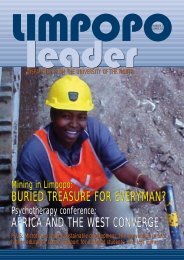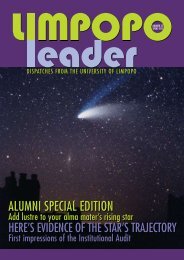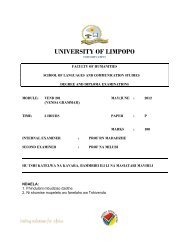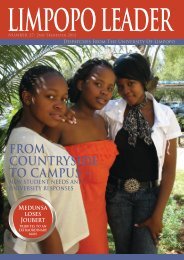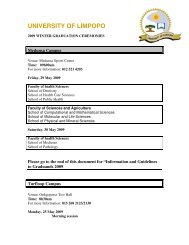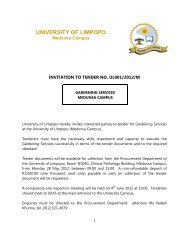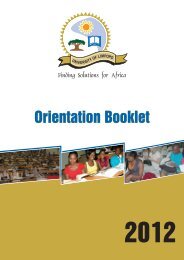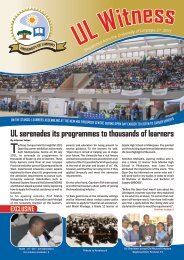Limpopo Leader - Spring 2005 - University of Limpopo
Limpopo Leader - Spring 2005 - University of Limpopo
Limpopo Leader - Spring 2005 - University of Limpopo
You also want an ePaper? Increase the reach of your titles
YUMPU automatically turns print PDFs into web optimized ePapers that Google loves.
Ecology:<br />
THE LEGACY OF ANTS<br />
fFEW TRAVELLERS TO THE FAMOUS FLOWERS OF<br />
NAMAQUALAND KNOW OF THE EXISTENCE OF<br />
THE UNIQUE AGE-OLD TERMITE NESTS TO BE<br />
FOUND IN THIS BEAUTIFUL AREA OF SOUTH<br />
AFRICA.<br />
According to scientists, some <strong>of</strong> the older <strong>of</strong><br />
these inactive termite nests are between 25 000 and<br />
30 000 years old. The termites, scientifically known<br />
as Microhodotermis viator, built amazingly huge nests<br />
with an average height <strong>of</strong> one metre and a diameter<br />
<strong>of</strong> up to 30 metres. It is, therefore, quite apt that these<br />
nests are known as heuweltjies (hillocks) among the<br />
residents <strong>of</strong> Namaqualand. Millions <strong>of</strong> these<br />
heuweltjies are found on the West Coast from the<br />
Piketberg area up to the border with Namibia.<br />
Research shows that the Cape climate at the time<br />
<strong>of</strong> the building <strong>of</strong> the termite heuweltjies supported an<br />
open savannah area, more suited to the prevalence<br />
<strong>of</strong> termites. The current semi-desert heuweltjie-studded<br />
landscape is, therefore, a telling example <strong>of</strong> the results<br />
<strong>of</strong> climate change.<br />
But there’s a lot more to the heuweltjies than this.<br />
They’re easily recognisable by the unique vegetation<br />
to be found on them. This vegetation differs from the<br />
surrounding vegetation and is the result <strong>of</strong> changed<br />
soil and other characteristics that are connected with<br />
the termite nests. As the plant species that grow on<br />
the heuweltjies are, according to livestock farmers in<br />
the area, tasty to the livestock that is farmed in<br />
Namaqualand, heuweltjies form an important<br />
management component <strong>of</strong> the small-animal industry in<br />
the area. Not only are the heuweltjies important to the<br />
livestock farmers for management purposes, but the<br />
grain farmers in the area are also affected by the<br />
changing characteristics <strong>of</strong> the soil as a result <strong>of</strong> the<br />
prevalence <strong>of</strong> heuweltjies.<br />
Little scientifically-founded knowledge on<br />
heuweltjies is available and even the recommended<br />
Pr<strong>of</strong>essor Dirk Wessels<br />
carrying capacity <strong>of</strong> heuweltjie veld is still<br />
scientifically unfounded at present.<br />
Research on Namaqualand’s heuweltjies now forms<br />
part <strong>of</strong> an interdisciplinary, international research<br />
project known as ‘BIOTA South’, funded primarily<br />
by the German government. This ambitious project<br />
comprises a research trajectory from the southern tip<br />
<strong>of</strong> South Africa to the border <strong>of</strong> Angola, with a branch<br />
<strong>of</strong>f to the lichen fields <strong>of</strong> the central Namib desert.<br />
Here, research is being done on a number <strong>of</strong> subjects<br />
ranging from lichens, soil fungi, plants and animals, to<br />
agricultural and socio-economic aspects <strong>of</strong> farmers<br />
and other communities in the trajectory.<br />
Scientists from a number <strong>of</strong> universities and other<br />
institutions in Germany, as well as universities and<br />
government departments in South Africa and Namibia,<br />
are participating. Pr<strong>of</strong>essor Dirk Wessels <strong>of</strong> the<br />
<strong>University</strong> <strong>of</strong> <strong>Limpopo</strong>, an expert on the lichen fields<br />
<strong>of</strong> the Namib, is part <strong>of</strong> a specialist group <strong>of</strong><br />
international scientists led by Pr<strong>of</strong>essor Burkhard Büdel<br />
<strong>of</strong> the <strong>University</strong> <strong>of</strong> Kaiserslautern in Germany doing<br />
research on the biological soil crust <strong>of</strong> heuweltjies and<br />
other areas in the research trajectory.<br />
P A G E 2 7



